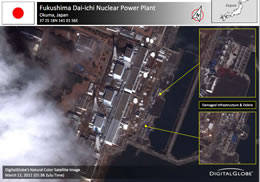

The nuclear reactor situation in Japan has deteriorated significantly. Two more explosions occurred at the Fukushima Daiichi nuclear power plant on March 15.
The first occurred at 6:10 a.m. local time at reactor No. 2, which had seen nuclear fuel rods exposed for several hours after dropping water levels due to mishaps in the emergency cooling efforts. Within three hours the amount of radiation at the plant rose to 163 times the previously recorded level, according to Japan’s Nuclear and Industrial Safety Agency.
Elsewhere, radiation levels were said to have reached 400 times the “annual legal limit” at reactor No. 3. Authorities differed on whether the reactor pressure vessel at reactor No. 2 was damaged after the explosion, but said the reactor’s pressure-suppression system may have been damaged possibly allowing a radiation leak. After this, a fire erupted at reactor No. 4 and was subsequently extinguished, according to Kyodo. Kyodo also reported the government has ordered a no-fly zone 30 kilometers around the reactor, and Prime Minister Naoto Kan has expanded to 30 kilometers the range within which citizens should remain indoors and warned that further leaks are possible.

The Japanese government has announced a 30-kilometer no-fly zone and is expanding evacuation zones and urging the public within a wider area to remain indoors. The situation at the nuclear facility is uncertain, but clearly deteriorating. Currently, the radiation levels do not appear immediately life-threatening outside the 20-kilometer evacuation zone. But if there is a steady northerly wind, the potential for larger-scale evacuations of more populated areas may become a reality. This would present major challenges to the Japanese government. Further, the potential for panic-induced individual evacuations could trigger even greater problems for the government to manage.
Read more: Red Alert: Radiation Rising and Heading South in Japan | STRATFOR
















